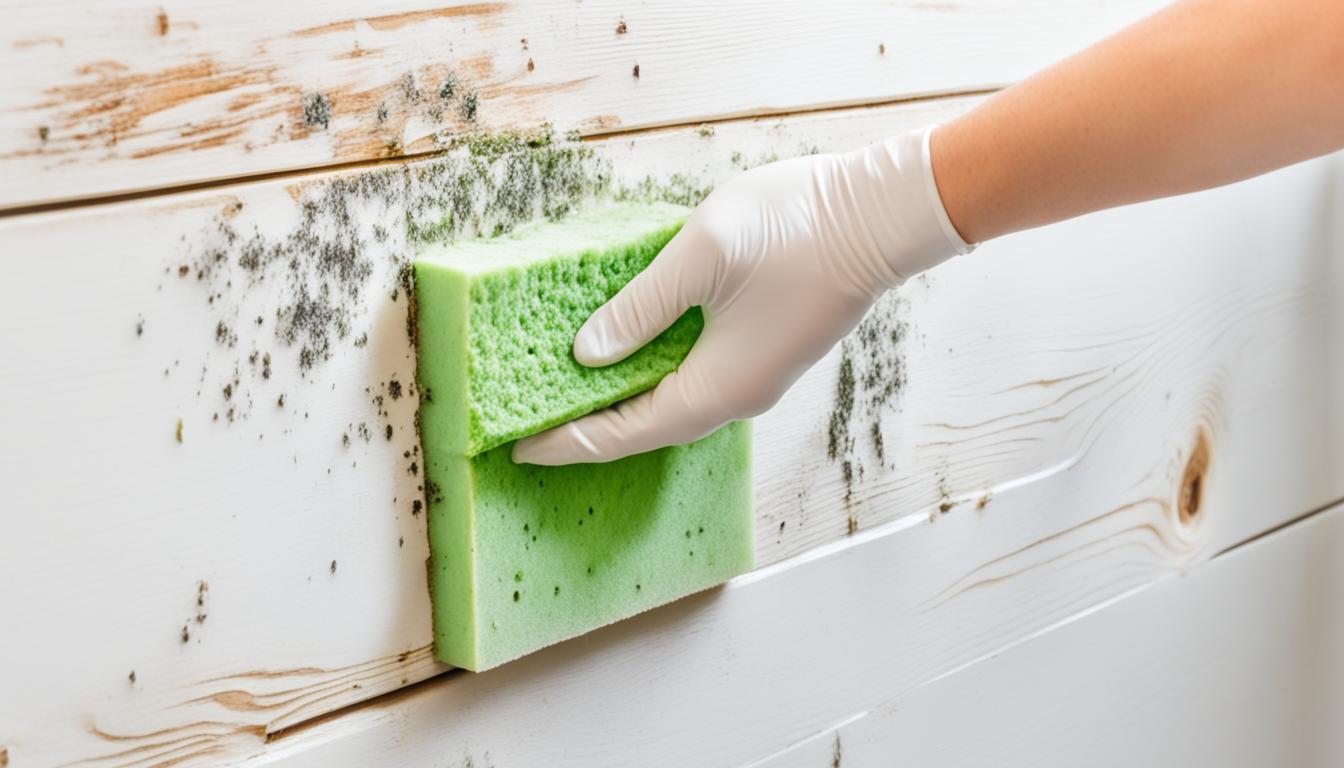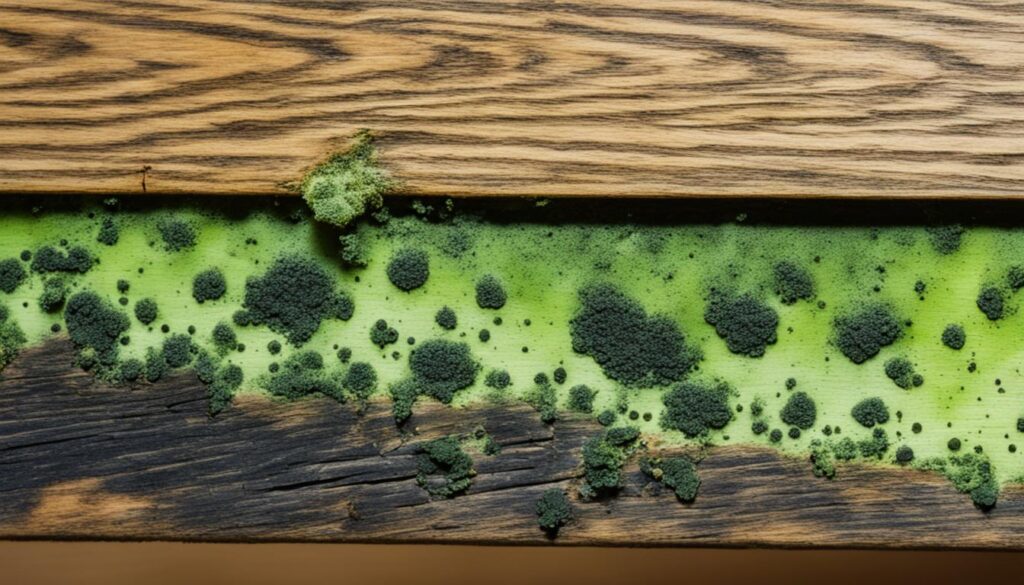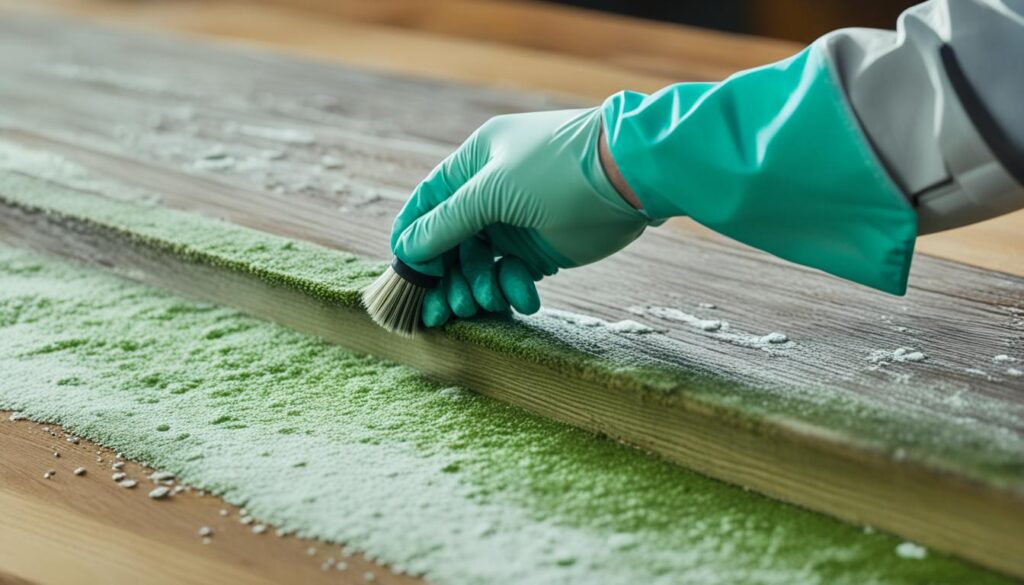
Eradicate Mold on Wood: Best Methods & Tips
Welcome to our guide on eradicating mold from wood surfaces. Mold can quickly become a stepping stone to various health issues and structural damage if not addressed promptly. In this section, we will provide you with the best methods and tips to eliminate mold from wood surfaces effectively. By following these strategies, you can ensure a safe and mold-free environment in your home.
Key Takeaways:
- Understanding the nature of mold on wood surfaces is crucial for effective remediation.
- Identify the common causes of mold growth on wood and take preventive measures to keep it at bay.
- Both DIY solutions and professional mold remediation services are available for eliminating mold from wood.
- Implement preventive strategies to minimize the chances of mold reappearing.
- Seek professional assistance for extensive mold infestations.
Understanding Mold on Wood
Before we dive into the methods to eradicate mold on wood, it is crucial to understand the nature of mold and its relationship with wooden surfaces. Mold, a type of fungus, can grow on various surfaces, including wood. It thrives in damp and humid environments, making wood an ideal breeding ground. Mold on wood surfaces not only poses health risks but can also cause structural damage if left untreated.
Common causes of mold growth on wood include:
- Excessive moisture: When wood is exposed to high humidity levels or water leaks, it creates a favorable environment for mold to flourish.
- Poor ventilation: Insufficient airflow in areas with wooden surfaces can lead to moisture buildup and mold infestation.
- Water damage: Whether from flooding or water leaks, excessive moisture can penetrate the wood, providing the perfect conditions for mold growth.
To identify mold on wood, look out for visible signs such as discoloration, black or green patches, a musty odor, or a fuzzy texture. It’s essential to address mold on wood surfaces promptly to prevent its spread and minimize health risks.
While you can visually assess the presence of mold on wood, a professional mold assessment provides a comprehensive evaluation of the extent of the infestation. A certified mold assessor can use advanced techniques to detect hidden mold and identify any underlying issues causing mold growth.

Preventing mold on wood surfaces requires proactive measures to control moisture. Here are some mold prevention tips:
- Maintain proper ventilation in your home, especially in areas prone to moisture accumulation, such as bathrooms, kitchens, and basements.
- Address any water leaks or plumbing issues immediately. Repairing leaks prevents water from seeping into the wood and creating a favorable environment for mold growth.
- Keep indoor humidity levels below 50% to discourage mold growth. Use dehumidifiers or air conditioners in humid climates.
- Regularly inspect and clean wooden surfaces, ensuring they are dry and free from moisture. Use appropriate cleaning agents and techniques to remove any mold spores.
- Seal and protect wooden surfaces with mold-resistant products to create a barrier against mold growth.
In the next section, we will explore effective strategies to eliminate mold from wood surfaces. We will provide you with step-by-step techniques, including both DIY solutions and professional mold remediation options, to help you eradicate mold and prevent its recurrence.
Effective Strategies to Eliminate Mold from Wood Surfaces
Now that we have a good understanding of mold on wood, it’s time to explore the effective strategies to eliminate it. In this section, we will delve into the step-by-step techniques for removing mold from wooden surfaces. We will cover both DIY solutions and when it’s best to seek professional mold remediation services. Additionally, we will provide you with preventive measures and strategies to minimize the chances of mold reappearing on your wood surfaces.
Step-by-Step Mold Removal Techniques for Wood Surfaces
- Identify the mold: Start by visually inspecting the wood surface for visible signs of mold growth. Look for discoloration, fuzzy patches, or a musty odor. It’s important to determine the extent of the mold infestation before proceeding with the removal process.
- Prepare protective gear: Mold remediation can expose you to harmful spores. Before starting, make sure to wear personal protective equipment (PPE) such as gloves, goggles, and a respirator to protect yourself.
- Contain the area: To prevent the spread of mold spores, isolate the affected area by covering nearby furniture and sealing off vents or doorways using plastic sheets or tarps.
- Clean the wood surface: Depending on the severity of the mold growth, you can use either a commercial mold cleaner or a homemade solution like a mixture of vinegar and water. Scrub the affected area gently with a brush or sponge, ensuring you reach into crevices and cracks.
- Dry the wood: After cleaning, thoroughly dry the wood surface to prevent further mold growth. Use fans, dehumidifiers, or open windows to promote airflow and reduce moisture.
- Monitor for recurrence: Even after successfully removing mold from wood surfaces, it’s essential to keep a close eye on the area for any signs of mold reemergence. Implement preventive measures to minimize humidity and moisture levels.
Remember, in some cases, especially for extensive mold infestations or if you have underlying water damage, it is highly recommended to seek professional mold remediation services. They have the expertise, tools, and knowledge to effectively eliminate mold and address the root cause of the problem.
Preventive Strategies to Minimize Mold Growth on Wood
Prevention is key to avoiding mold growth on wood surfaces. Follow these strategies to minimize the chances of mold reappearing:
- Control humidity levels: Maintain relative humidity below 50% to inhibit mold growth. Use dehumidifiers, air conditioners, or exhaust fans to reduce moisture in your home.
- Fix water leaks: Promptly repair any plumbing or roof leaks to prevent water intrusion that can lead to mold growth. Inspect and maintain your home’s plumbing system regularly.
- Improve ventilation: Proper airflow helps to reduce moisture levels. Open windows and use extractor fans in areas prone to high humidity, such as bathrooms, kitchens, and basements.
- Seal wood surfaces: Apply a protective sealant or paint to wood surfaces to prevent moisture absorption and create a barrier against mold.
- Clean and dry promptly: Address any spills or water damage immediately. Thoroughly dry any wet surfaces, including carpets, upholstery, and wood, within 24-48 hours.
By implementing these preventive strategies and using effective mold removal techniques, you can maintain a mold-free and healthy environment in your home.

When to Consult a Professional for Mold Removal
“If you notice extensive mold growth on your wood surfaces, especially in hard-to-reach or hidden areas, it’s best to consult a professional mold remediation specialist. They have the expertise and equipment to handle complex mold infestations safely and efficiently.”
Don’t let mold compromise the beauty and integrity of your wooden surfaces. By using the right techniques, taking preventive measures, and seeking professional assistance when necessary, you can effectively eliminate mold and safeguard your home from its harmful effects.
| Mold Removal Techniques | Mold Remediation | Mold Prevention Strategies |
|---|---|---|
| Identify mold Clean wood surface Dry the wood |
Consult a professional for extensive mold growth | Control humidity levels Fix water leaks Improve ventilation Seal wood surfaces Clean and dry promptly |
Conclusion
In conclusion, mold growth on wood can pose significant health risks and cause damage to your property. However, you can take effective measures to eradicate mold from wood surfaces and prevent its recurrence by following the best methods and tips discussed in this article.
It is important to note that when dealing with extensive mold infestation, seeking professional assistance is highly recommended. These experts have the knowledge and tools to handle the situation safely and effectively.
By implementing the preventive measures mentioned throughout this article, you can maintain a clean and mold-free home. Regularly inspect your wooden surfaces, control humidity levels, and ensure adequate ventilation. Additionally, promptly address any water leaks or moisture issues to prevent mold growth.
If you require reliable mold assessments, prevention, and remediation services, Fix Mold Miami is a trusted provider. Contact them at 305-465-6653 to ensure your home remains free from mold and the associated health hazards. Don’t let mold compromise the safety and well-being of your loved ones and your property.




